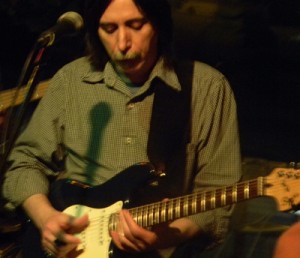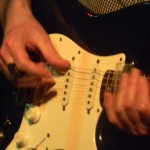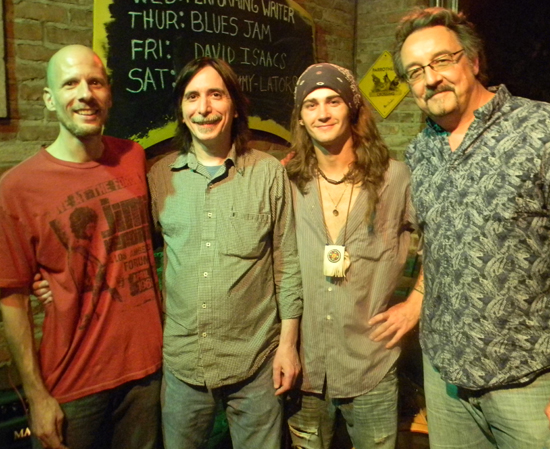jazz
Jack Pearson at the Nashville Berklee Jam – August 14, 2011
Guitarist, singer, songwriter, producer and session-musician, Jack Pearson shared some unique perspective about his musical journey with a room full of Berklee alumni and others from the Nashville music community last Tuesday. The Nashville Berklee Jam, held monthly at the Fillin’ Station in Kingston Springs, saw some new faces and old friends on this special night, and Jack’s decades of experience as a world-class musician provided a rare peek behind the curtain for all those in attendance.
Jack’s musical career began in the mid 1970’s, when he played in multiple bands and logged his first recording session at age 16. In 1993 the Nashville native began his relationship with The Allman Brothers Band as a sub for Dickey Betts, eventually becoming a member of the ABB from 1997-1999 and also touring with Gregg Allman & Friends. Over the years he’s also worked with Vince Gill, Delbert McClinton, Jimmy Buffett, Earl Scruggs, Bobby “Blue” Bland, Amy Grant, Faith Hill, Gov’t Mule, Buddy DeFranco, and countless others.
Jack began his part of this night by playing some beautiful sketches of “I Can’t Get Started”, and for those who have never heard him play, his ability to transport an audience through time and space with nothing other than an unaccompanied electric guitar became quickly apparent. Following the spontaneous applause, Jack cut straight to some Q & A. One of the first questions asked was about his guitar, and I found it interesting that the deep, rich tone coming out of our backline Fender Deluxe originated from a Fender “Squire” Stratocaster, which he had recently bought for $100 at a pawn shop. Plugged into nothing other than a lone tube screamer, this drove home the point that great tone comes from within.
Learning from his oldest brother, Jack was exposed to rockabilly and blues as a teenager and explored the music of Chuck Berry, The Ventures, and Carl Perkins at a young age before eventually discovering jazz greats like, Wes Montgomery, Django Reinhardt, and Charlie Christian. Learning from friends, other musicians, and records, he slowly pieced together his musical vocabulary. He shared some thoughts on how to approach a II-V turnaround, demonstrating some different voicings and melodic approaches, underscoring the importance of putting song and melody above the technical understanding of modes and scales.
 “It takes a lot of experimenting… a lot of guys come to me that get out of school and they say, “when I hear this chord I’m supposed to play this mode and scale”, and it locks them up. They can’t make any melodies because they’re told to play a mode or a scale.”
“It takes a lot of experimenting… a lot of guys come to me that get out of school and they say, “when I hear this chord I’m supposed to play this mode and scale”, and it locks them up. They can’t make any melodies because they’re told to play a mode or a scale.”
This simple, but prophetic thought resonated, and I had flashes to a time in my life when I over analyzed the music I played. Jack drove this point home with “…it comes down to the chord and the melody and where it’s going to…”
He went on to talk about the blending of styles and how he went through different periods of his life where he would be deeply immersed in a singular style for a few years – Delta blues, jazz, etc., and that after a while, all these different styles started coming together. Not afraid to take some chances musically, he demonstrated how he might go from a Howlin’ Wolf lick to a Charlie Parker lick within the same phrase, and that while some players will say this is wrong, he believes that “the main thing is to get the music out, and play with feeling.”
In response to a question about some of his best and worst gigs, Jack said that some of the worst gigs are when people don’t listen, and the music that you play with somebody is more important than the venue, or how famous somebody is.
He explained how learning all of the Allman Brothers songs as a kid helped put him in the position to sub for Dickey Betts on an early 90s Allman Brothers tour, which led to some recording with Gregg Allman and eventually to a phone call from Greg in which he was asked if he wanted to join the Allman Brothers band.
He candidly shared how this landmark gig damaged his hearing, causing an already existing case of Tinnitus to worsen, ultimately forcing him to leave the gig, perhaps sooner than he otherwise would have.
“There’s really no way to describe how loud it was on stage…Dickey Betts wasn’t in the PA…he was 135 dB side stage…”
As a fellow tinnitus sufferer I completely related to this portion of his talk and gained some new perspective as he explained that, despite wearing earplugs, extreme SPL’s (sound pressure levels) can still do damage, as the sound can affect your inner ear by entering your nose, mouth, and through your bones.
In response to a question about life lessons learned through music he answered, “Try not to take music for granted, it’s so special, and you can reach so many people…lyrics can encourage you, relate to your pain, but you can also do it with notes.” He demonstrated this by showing how the same group of notes can sound happy, or sad depending on where the emphasis is placed. He talked about the endless possibilities of how you can play even a single note, demonstrating this concept by playing a huge range of variances on a high “G” note.
After Jack’s talk concluded he played a short set with our Alumni House Band, the air becoming filled with the sounds of spontaneous applause after each inspired performance. Jack left shortly after his set, and the other alums in attendance continued jamming into the night. I, and everyone else in attendance would like to extend our appreciation and gratitude to Jack for sharing his music and journey on this special night!
Our next Nashville Berklee Jam will feature country music artist and hit-songwriter, Rhett Akins on Tuesday, September 11 at The Fillin’ Station. For more info, go to www.nashvilleberkleejam.com.
Vibrato is King
As a guitarist, having good control of vibrato has been a key component in my ability to effectively communicate through my  instrument. For many music purists, the use of vibrato has been widely debated, as so many artists and performers have used it with such a wide variance of efficiency and taste. There is the rapid fire, “billy goat” style vibrato as used by singers like Joan Baez and Eddie Vetter, the emotive, stinging vibrato used by guitarists like Jimi Hendrix and Buddy Guy, and the stark, subtle almost non-vibrato of Miles Davis. All these styles, and others, have their place, but some approaches, arguably, may be more effective than others.
instrument. For many music purists, the use of vibrato has been widely debated, as so many artists and performers have used it with such a wide variance of efficiency and taste. There is the rapid fire, “billy goat” style vibrato as used by singers like Joan Baez and Eddie Vetter, the emotive, stinging vibrato used by guitarists like Jimi Hendrix and Buddy Guy, and the stark, subtle almost non-vibrato of Miles Davis. All these styles, and others, have their place, but some approaches, arguably, may be more effective than others.
When I was first learning how to play guitar, it took all of my ability to simply play notes and chords cleanly, I wasn’t even aware of what vibrato was. A few years later, as I progressed, I gradually began to learn about the concept of vibrato from other guitarists. But my early development, similar to that of many guitarists, led to a quest for speed, rather than emotional content. When you are playing fast all the time, there is little time for vibrato as you never land on one note long enough to apply it. Fortunately, my early possession by a speed demon eventually came to an end, and a stronger, more pronounced sense of vibrato gradually became inherent to my playing.
What is vibrato? Here is a definition from the website answers.com:
“Vibrato is a musical effect consisting of a regular pulsating change of pitch. It is used to add expression to vocal and instrumental music. Vibrato can be characterized by the amount of pitch variation (“depth of vibrato”) and speed with which the pitch is varied (“speed of vibrato”).”
It goes on to say:
“The use of vibrato is intended to add warmth to a note. In the case of many string instruments the sound emitted is strongly directional, particularly at high frequencies, and the slight variations in pitch typical of vibrato playing can cause large changes in the directional patterns of the radiated sound. This can add a shimmer to the sound; with a well-made instrument it may also help a solo player to be heard more clearly when playing with a large orchestra. This directional effect is intended to interact with the room acoustics to add interest to the sound, in much the same way as an acoustic guitarist may swing the box around on a final sustain, or the rotating baffle of a Leslie speaker will spin the sound around the room.”
 This brings up my first point, the battle to be heard. Although they are using classical music in the context of an orchestra, I believe the concept is universal. If you’re performing with a live amplified band, whether singing a lead vocal, playing a signature lick on a violin, or wailing a guitar solo, there is usually an effort required to make those notes audible and impactive above the roar of the band. Think of the total sound made by the band as one giant wall of sound. The lead melody, in most situations, is simply a group of chord tones and passing tones that fit into that wall of sound. A good strong melody in and of itself usually contains enough motion to create a contrast against the wall of sound, but when the melody sustains on a note, it begins to blend in. Using vibrato on those sustaining notes and at the end of phrases can create additional movement and allow the note to have a greater contrast against the otherwise static wall of sound upon which it sits.
This brings up my first point, the battle to be heard. Although they are using classical music in the context of an orchestra, I believe the concept is universal. If you’re performing with a live amplified band, whether singing a lead vocal, playing a signature lick on a violin, or wailing a guitar solo, there is usually an effort required to make those notes audible and impactive above the roar of the band. Think of the total sound made by the band as one giant wall of sound. The lead melody, in most situations, is simply a group of chord tones and passing tones that fit into that wall of sound. A good strong melody in and of itself usually contains enough motion to create a contrast against the wall of sound, but when the melody sustains on a note, it begins to blend in. Using vibrato on those sustaining notes and at the end of phrases can create additional movement and allow the note to have a greater contrast against the otherwise static wall of sound upon which it sits.
Leopold Mozart, father of the famous composer Wolfgang Amadeus Mozart, wrote a textbook for violin instruction, Versuch einer gründlichen Violinschule which was published in 1756. In it he writes “there are performers who tremble consistently on each note as if they had the permanent fever. ” Although he ultimately condemned the practice, he does go on to suggest that vibrato should only be used on sustained notes and at the end of phrases.
This is where the line between preference and taste becomes greatly blurred. Many successful artists use an excessive amount of vibrato, such as the previously mentioned vocalists, and this creates the trembling effect as noted by Mozart. And while this does not prevent these artists from having successful careers, this kind of “billy goat” style vibrato is often the result of a less than stellar technique. The lead melody was already designed to sit on top of the mix, containing enough inner motion to do so without constant vibrato. By singing with a constant vibrato, it’s like putting extra notes in where they weren’t intended. Some musicians and singers create these habits early on and simply choose to stick with what works for them.
Now take this to the other extreme. Listen to, or envision the sound of a great David Gilmour guitar solo. The fast passages are  played cleanly with no vibrato, but then at the end of the phrase, he might just sit on the last note for a few seconds before slowly and incrementally adding some substantial vibrato, usually at a speed that is a subdivision of the songs tempo. A lot of great blues and jazz musicians also employed this technique as well as vocalists like Etta James, Ray Charles, Frank Sinatra, and Paul Rogers.
played cleanly with no vibrato, but then at the end of the phrase, he might just sit on the last note for a few seconds before slowly and incrementally adding some substantial vibrato, usually at a speed that is a subdivision of the songs tempo. A lot of great blues and jazz musicians also employed this technique as well as vocalists like Etta James, Ray Charles, Frank Sinatra, and Paul Rogers.
This concept radiates my other point, our need to express. Music is simply communication. As a musician we are trying to convey or communicate stories, concepts, ideals, and emotions. Vibrato is simply one of the tools on our palate. So are dynamics, volume, speed, phrasings, etc. If you play constant 16th notes in your solos or drum fills, there is no contrast, the passages will be static and predictable. Insert some slower phrases within the fast flurries and the slow passages will create a contrast, ultimately giving more meaning to the 16th notes. I believe the same is true for vibrato. Use it constantly, and there is no contrast. Use it where it is most needed and most effective, and it will only serve to enhance your overall expressiveness.
From an electric guitarists standpoint, I like to use vibrato not only to create drama within a lead line, but also to help coax more sustain out of a note, and at times to induce controlled feedback. I’ve also adopted the technique of adding vibrato to the end of a bent note, a trick I learned from listening to recordings of guitarists like Jimi Hendrix and SRV. Of course, some would argue that true vibrato must come from a feeling, not a thought
This is all highly subjective and to be taken in stride. Explore the endless possibilities of vibrato but don’t overthink it, it should feel natural. Like one of my great instructors at Berklee once said “Practice your technique at home. But when you get to the gig, just play.”


